2017 NISSAN LEAF charging
[x] Cancel search: chargingPage 3 of 48
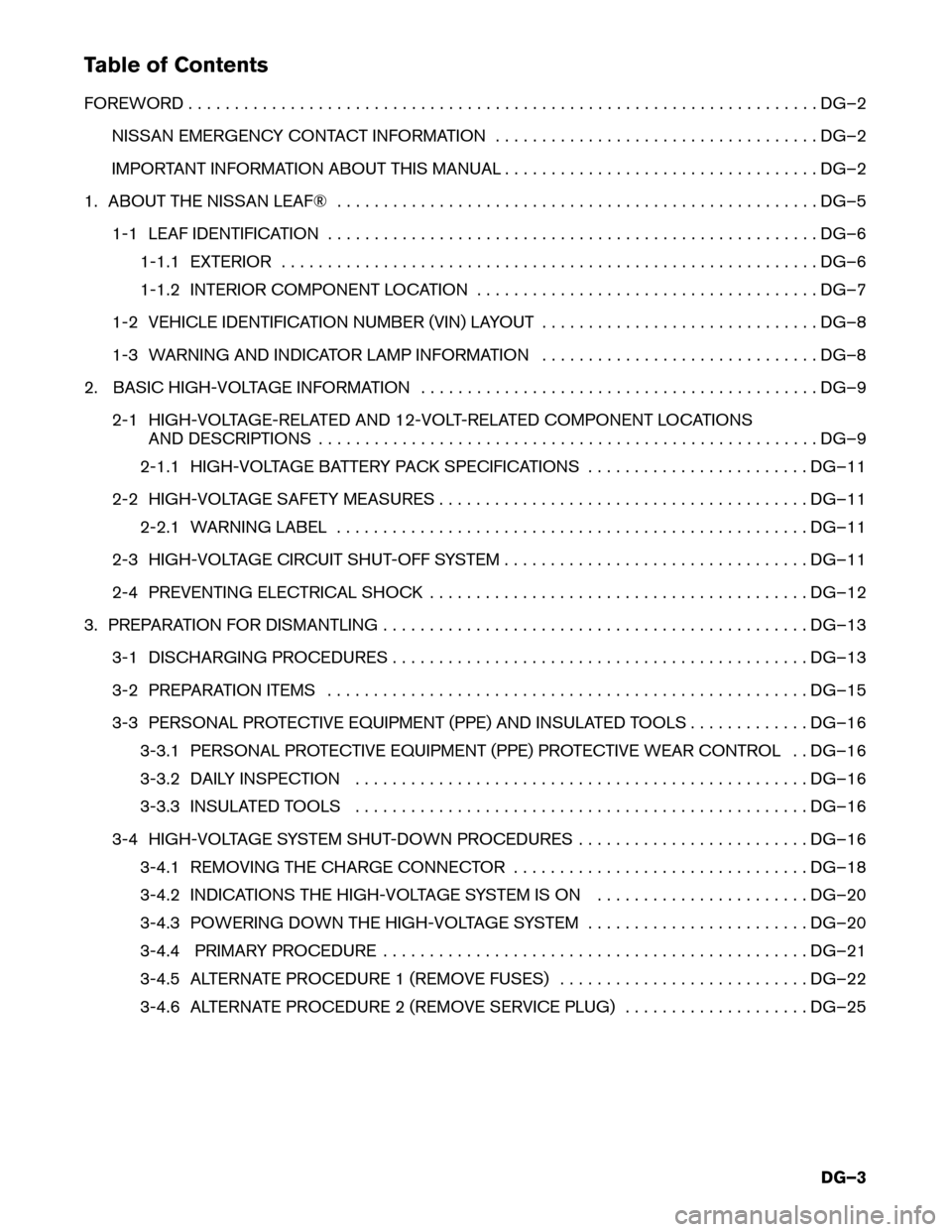
Table of Contents
FOREWORD
. . . . . . . . . . . . . . . . . . . . . . . . . . . . . . . . . . . . . . . . . . . . . . . . . . . . . . . . . . . . . . . . . . . . DG–2
NISSAN EMERGENCY CONTACT INFORMATION . . . . . . . . . . . . . . . . . . . . . . . . . . . . . . . . . . . DG–2
IMPORTANT INFORMATION ABOUT THIS MANUAL . . . . . . . . . . . . . . . . . . . . . . . . . . . . . . . . . . DG–2
1. ABOUT THE NISSAN LEAF® . . . . . . . . . . . . . . . . . . . . . . . . . . . . . . . . . . . . . . . . . . . . . . . . . . . . DG–5
1-1 LEAF IDENTIFICATION . . . . . . . . . . . . . . . . . . . . . . . . . . . . . . . . . . . . . . . . . . . . . . . . . . . . . DG–6 1-1.1 EXTERIOR . . . . . . . . . . . . . . . . . . . . . . . . . . . . . . . . . . . . . . . . . . . . . . . . . . . . . . . . . . DG–6
1-1.2 INTERIOR COMPONENT LOCATION . . . . . . . . . . . . . . . . . . . . . . . . . . . . . . . . . . . . . DG–7
1-2 VEHICLE IDENTIFICATION NUMBER (VIN) LAYOUT . . . . . . . . . . . . . . . . . . . . . . . . . . . . . . DG–8
1-3 WARNING AND INDICATOR LAMP INFORMATION . . . . . . . . . . . . . . . . . . . . . . . . . . . . . . DG–8
2. BASIC HIGH-VOLTAGE INFORMATION . . . . . . . . . . . . . . . . . . . . . . . . . . . . . . . . . . . . . . . . . . . DG–9 2-1 HIGH-VOLTAGE-RELATED AND 12-VOLT-RELATED COMPONENT LOCATIONS AND DESCRIPTIONS . . . . . . . . . . . . . . . . . . . . . . . . . . . . . . . . . . . . . . . . . . . . . . . . . . . . . . DG–9
2-1.1 HIGH-VOLTAGE BATTERY PACK SPECIFICATIONS . . . . . . . . . . . . . . . . . . . . . . . . DG–11
2-2 HIGH-VOLTAGE SAFETY MEASURES . . . . . . . . . . . . . . . . . . . . . . . . . . . . . . . . . . . . . . . . DG–11 2-2.1 WARNING LABEL . . . . . . . . . . . . . . . . . . . . . . . . . . . . . . . . . . . . . . . . . . . . . . . . . . . DG–11
2-3 HIGH-VOLTAGE CIRCUIT SHUT-OFF SYSTEM . . . . . . . . . . . . . . . . . . . . . . . . . . . . . . . . . DG–11
2-4 PREVENTING ELECTRICAL SHOCK . . . . . . . . . . . . . . . . . . . . . . . . . . . . . . . . . . . . . . . . . DG–12
3. PREPARATION FOR DISMANTLING . . . . . . . . . . . . . . . . . . . . . . . . . . . . . . . . . . . . . . . . . . . . . . DG–13
3-1 DISCHARGING PROCEDURES . . . . . . . . . . . . . . . . . . . . . . . . . . . . . . . . . . . . . . . . . . . . . DG–13
3-2 PREPARATION ITEMS . . . . . . . . . . . . . . . . . . . . . . . . . . . . . . . . . . . . . . . . . . . . . . . . . . . . DG–15
3-3 PERSONAL PROTECTIVE EQUIPMENT (PPE) AND INSULATED TOOLS . . . . . . . . . . . . . DG–163-3.1 PERSONAL PROTECTIVE EQUIPMENT (PPE) PROTECTIVE WEAR CONTROL . . DG–16
3-3.2 DAILY INSPECTION . . . . . . . . . . . . . . . . . . . . . . . . . . . . . . . . . . . . . . . . . . . . . . . . . DG–16
3-3.3 INSULATED TOOLS . . . . . . . . . . . . . . . . . . . . . . . . . . . . . . . . . . . . . . . . . . . . . . . . . DG–16
3-4 HIGH-VOLTAGE SYSTEM SHUT-DOWN PROCEDURES . . . . . . . . . . . . . . . . . . . . . . . . . DG–16 3-4.1 REMOVING THE CHARGE CONNECTOR . . . . . . . . . . . . . . . . . . . . . . . . . . . . . . . . DG–18
3-4.2 INDICATIONS THE HIGH-VOLTAGE SYSTEM IS ON . . . . . . . . . . . . . . . . . . . . . . . DG–20
3-4.3 POWERING DOWN THE HIGH-VOLTAGE SYSTEM . . . . . . . . . . . . . . . . . . . . . . . . DG–20
3-4.4 PRIMARY PROCEDURE . . . . . . . . . . . . . . . . . . . . . . . . . . . . . . . . . . . . . . . . . . . . . . DG–21
3-4.5 ALTERNATE PROCEDURE 1 (REMOVE FUSES) . . . . . . . . . . . . . . . . . . . . . . . . . . . DG–22
3-4.6 ALTERNATE PROCEDURE 2 (REMOVE SERVICE PLUG) . . . . . . . . . . . . . . . . . . . . DG–25
DG–3
Page 5 of 48

1. About The Nissan LEAF®
This
vehicle uses two types of batteries. One is a 12-volt battery that is the same as the battery in vehicles
powered by internal combustion engines, and the other is the high-voltage battery for the traction motor
which propels the vehicle. The high-voltage battery is encased in steel and mounted underneath the vehicle.
The vehicle must be plugged-in in order for the high-voltage battery to be recharged. Additionally, the
vehicle system can recharge the high-voltage battery by converting driving force into electricity while the
vehicle is decelerating or being driven downhill. This is called regenerative charging. This vehicle is
considered to be an environmentally friendly vehicle because it does not emit exhaust gases.
DG–5
Page 7 of 48
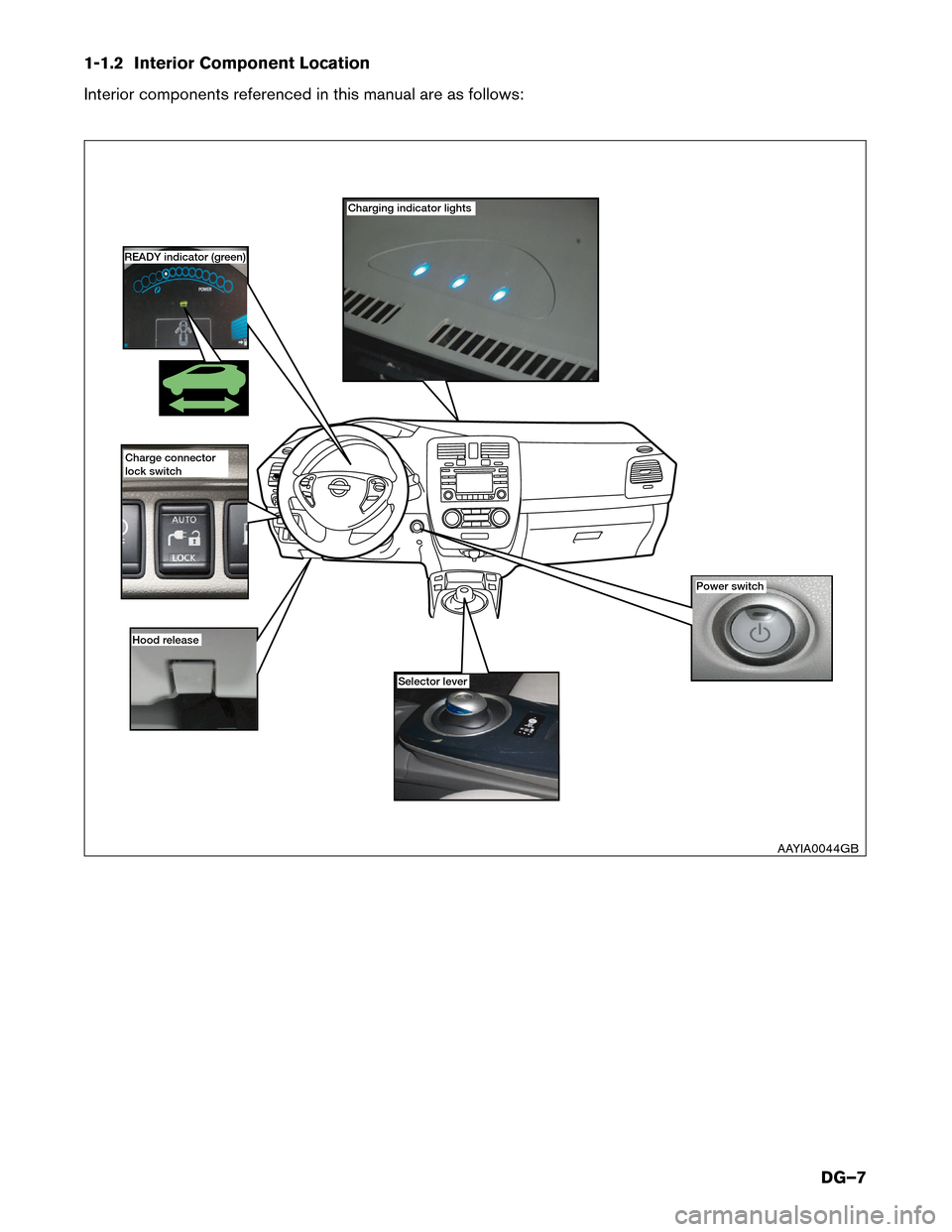
1-1.2 Interior Component Location
Interior
components referenced in this manual are as follows: Charging indicator lights
Power switch
Hood r
elease Selector lever
READY indicator (green)
Charge connector
lock switch
AAYIA0044GBDG–7
Page 11 of 48
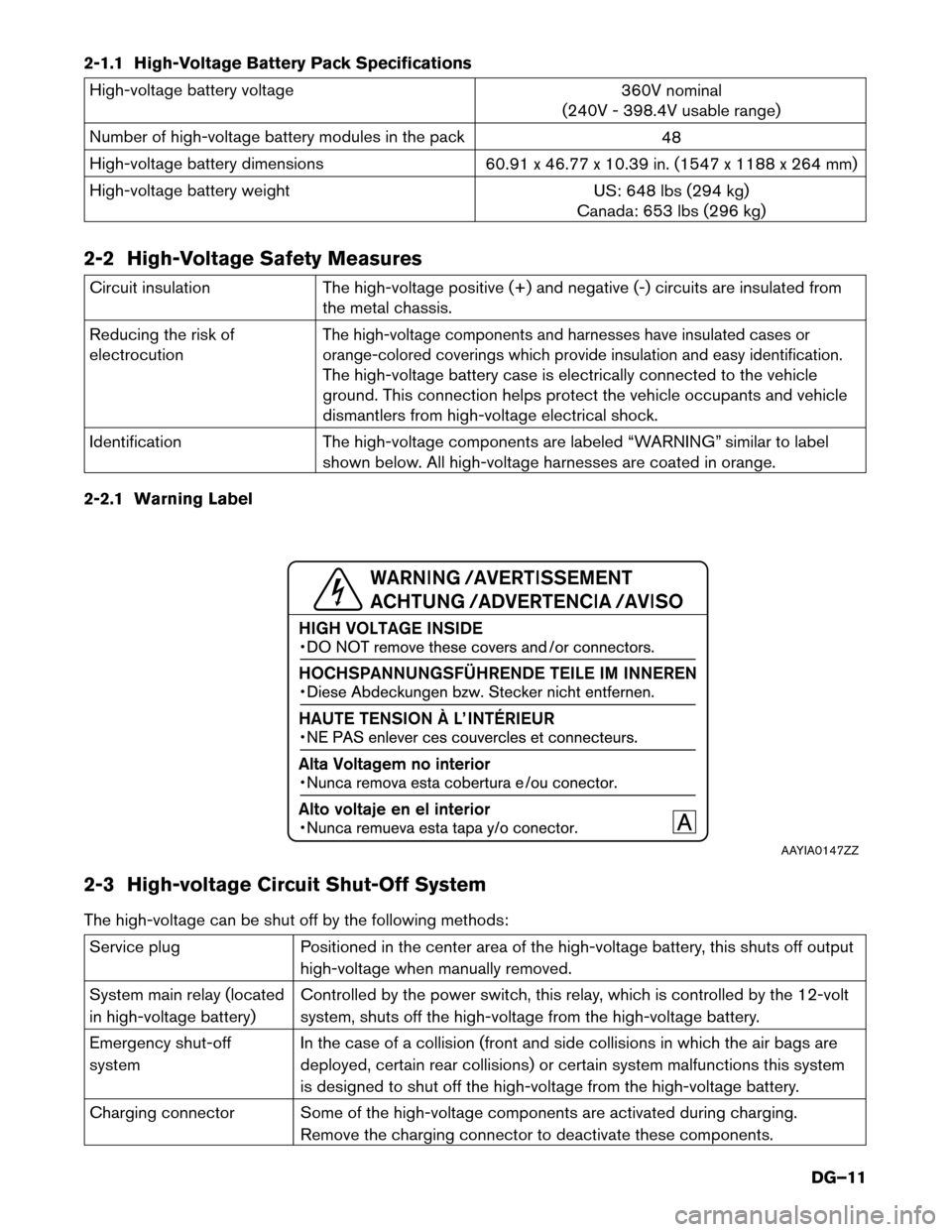
2-1.1 High-Voltage Battery Pack Specifications
High-voltage battery voltage
360V nominal
(240V - 398.4V usable range)
Number of high-voltage battery modules in the pack 48
High-voltage battery dimensions 60.91 x 46.77 x 10.39 in. (1547 x 1188 x 264 mm)
High-voltage battery weight US: 648 lbs (294 kg)
Canada: 653 lbs (296 kg)
2-2 High-Voltage Safety Measures Circuit insulation
The high-voltage positive (+) and negative (-) circuits are insulated from
the
metal chassis.
Reducing the risk of
electrocution
The high-voltage components and harnesses have insulated cases or
orange-colored coverings which provide insulation and easy identification.
The high-voltage battery case is electrically connected to the vehicle
ground. This connection helps protect the vehicle occupants and vehicle
dismantlers from high-voltage electrical shock.
Identification The high-voltage components are labeled “WARNING” similar to label shown below. All high-voltage harnesses are coated in orange.
2-2.1 Warning Label
2-3 High-voltage Circuit Shut-Off System
The high-voltage can be shut off by the following methods: Service plug
Positioned in the center area of the high-voltage battery, this shuts off output
high-voltage
when manually removed.
System main relay (located
in high-voltage battery) Controlled by the power switch, this relay, which is controlled by the 12-volt
system, shuts off the high-voltage from the high-voltage battery.
Emergency shut-off
system In the case of a collision (front and side collisions in which the air bags are
deployed, certain rear collisions) or certain system malfunctions this system
is designed to shut off the high-voltage from the high-voltage battery.
Charging connector Some of the high-voltage components are activated during charging. Remove the charging connector to deactivate these components. AAYIA0147ZZ
DG–11
Page 13 of 48
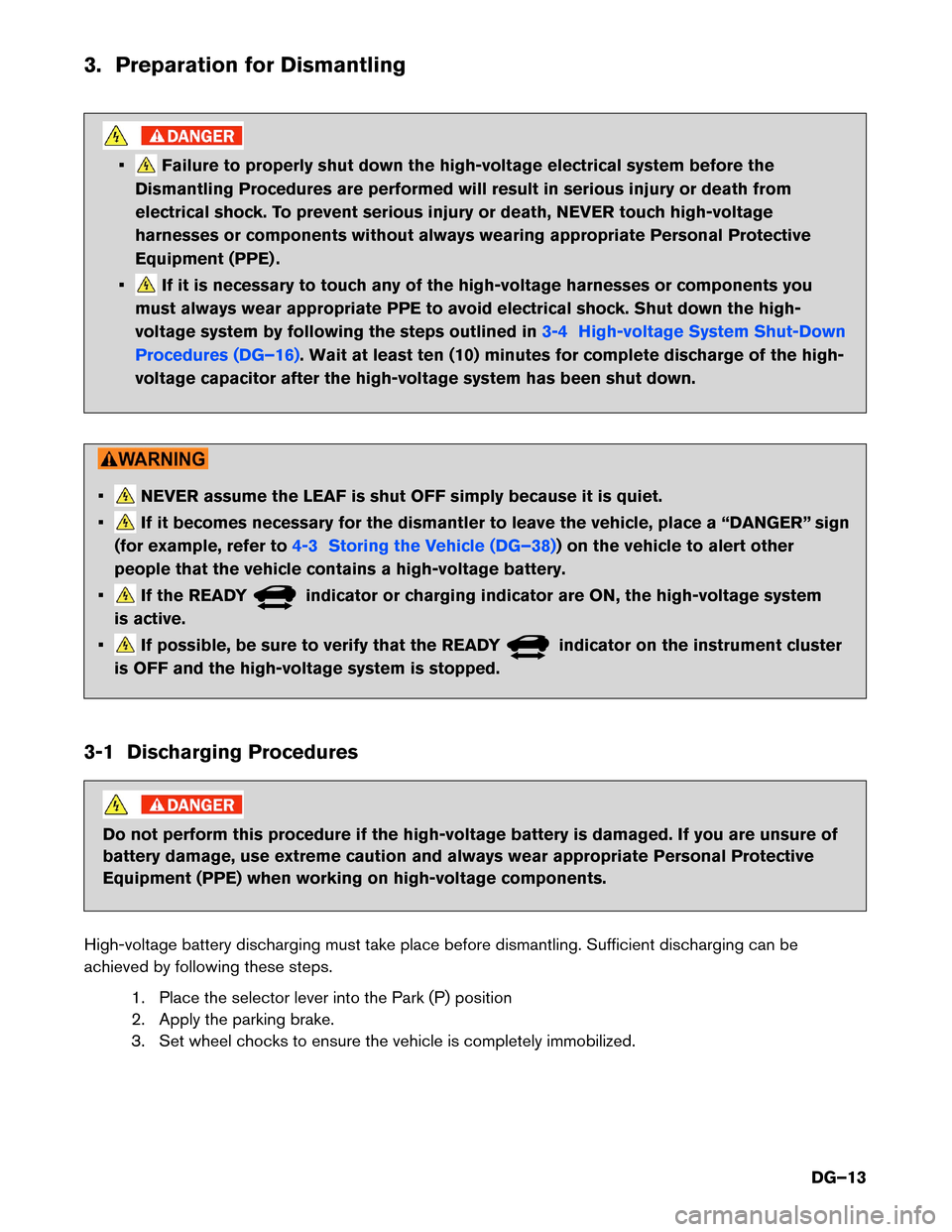
3. Preparation for Dismantling
• Failure to properly shut down the high-voltage electrical system before the
Dismantling Procedures are performed will result in serious injury or death from
electrical shock. To prevent serious injury or death, NEVER touch high-voltage
harnesses or components without always wearing appropriate Personal Protective
Equipment (PPE) .
• If it is necessary to touch any of the high-voltage harnesses or components you
must
always wear appropriate PPE to avoid electrical shock. Shut down the high-
voltage system by following the steps outlined in 3-4 High-voltage System Shut-Down
Procedures
(DG–16) . Wait at least ten (10) minutes for complete discharge of the high-
voltage
capacitor after the high-voltage system has been shut down. • NEVER assume the LEAF is shut OFF simply because it is quiet.
• If it becomes necessary for the dismantler to leave the vehicle, place a “DANGER” sign
(for
example, refer to 4-3 Storing the Vehicle (DG–38)) on the vehicle to alert other
people
that the vehicle contains a high-voltage battery.
• If the READY indicator or charging indicator are ON, the high-voltage system
is
active.
• If possible, be sure to verify that the READY indicator on the instrument cluster
is
OFF and the high-voltage system is stopped.
3-1 Discharging Procedures Do not perform this procedure if the high-voltage battery is damaged. If you are unsure of
battery
damage, use extreme caution and always wear appropriate Personal Protective
Equipment (PPE) when working on high-voltage components.
High-voltage battery discharging must take place before dismantling. Sufficient discharging can be
achieved by following these steps. 1. Place the selector lever into the Park (P) position
2. Apply the parking brake.
3. Set wheel chocks to ensure the vehicle is completely immobilized.
DG–13
Page 14 of 48
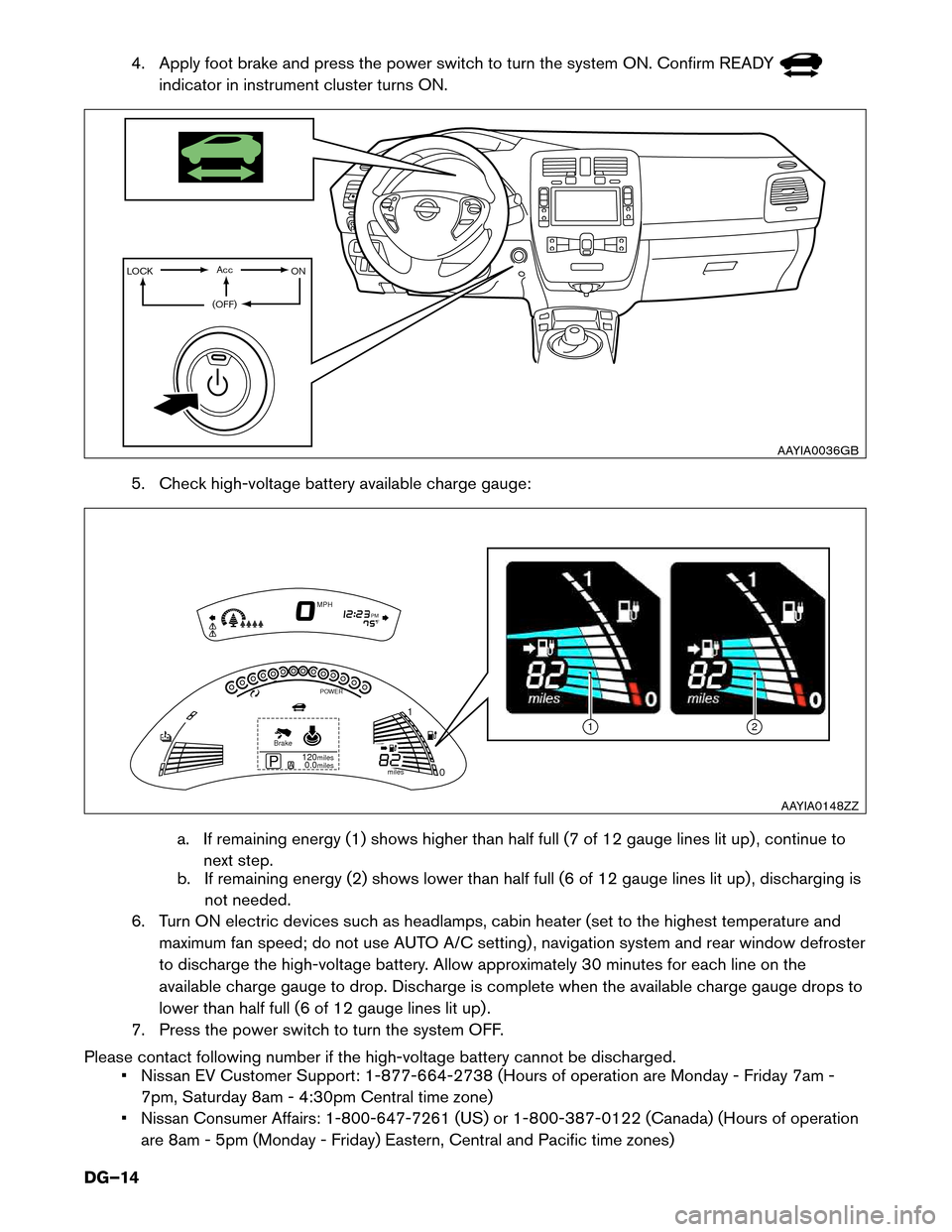
4. Apply foot brake and press the power switch to turn the system ON. Confirm READY
indicator in instrument cluster turns ON.
5. Check high-voltage battery available charge gauge: a. If remaining energy (1) shows higher than half full (7 of 12 gauge lines lit up) , continue to next step.
b. If remaining energy (2) shows lower than half full (6 of 12 gauge lines lit up) , discharging is
not needed.
6. Turn ON electric devices such as headlamps, cabin heater (set to the highest temperature and
maximum fan speed; do not use AUTO A/C setting) , navigation system and rear window defroster
to discharge the high-voltage battery. Allow approximately 30 minutes for each line on the
available charge gauge to drop. Discharge is complete when the available charge gauge drops to
lower than half full (6 of 12 gauge lines lit up) .
7. Press the power switch to turn the system OFF.
Please contact following number if the high-voltage battery cannot be discharged. • Nissan EV Customer Support: 1-877-664-2738 (Hours of operation are Monday - Friday 7am -
7pm, Saturday 8am - 4:30pm Central time zone)
•
Nissan Consumer Affairs: 1-800-647-7261(US) or 1-800-387-0122 (Canada) (Hours of operation
are 8am - 5pm (Monday - Friday) Eastern, Central and Pacific time zones) LOCK Acc
(OFF) ON AAYIA0036GB
0
1 POWER
Brake
P A 120miles
0.0miles MPH
PM
F miles 1 2
AAYIA0148ZZ
DG–14
Page 17 of 48
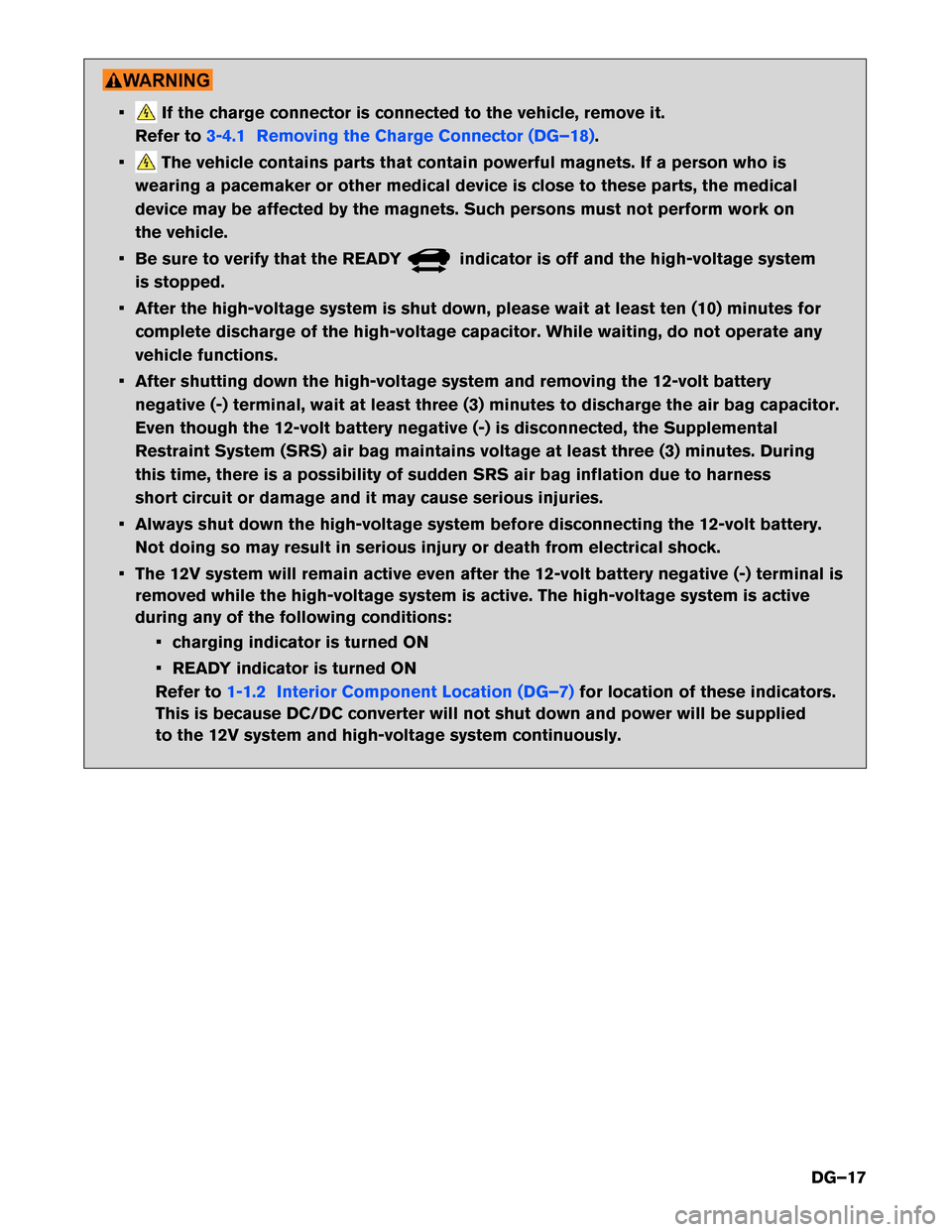
• If the charge connector is connected to the vehicle, remove it.
Refer to3-4.1 Removing the Charge Connector (DG–18).
• The vehicle contains parts that contain powerful magnets. If a person who is
wearing
a pacemaker or other medical device is close to these parts, the medical
device may be affected by the magnets. Such persons must not perform work on
the vehicle.
• Be sure to verify that the READY indicator is off and the high-voltage system
is
stopped.
• After the high-voltage system is shut down, please wait at least ten (10) minutes for complete discharge of the high-voltage capacitor. While waiting, do not operate any
vehicle functions.
• After shutting down the high-voltage system and removing the 12-volt battery negative (-) terminal, wait at least three (3) minutes to discharge the air bag capacitor.
Even though the 12-volt battery negative (-) is disconnected, the Supplemental
Restraint System (SRS) air bag maintains voltage at least three (3) minutes. During
this time, there is a possibility of sudden SRS air bag inflation due to harness
short circuit or damage and it may cause serious injuries.
• Always shut down the high-voltage system before disconnecting the 12-volt battery. Not doing so may result in serious injury or death from electrical shock.
• The 12V system will remain active even after the 12-volt battery negative (-) terminal is removed while the high-voltage system is active. The high-voltage system is active
during any of the following conditions:
• charging indicator is turned ON
• READY indicator is turned ON
Refer to 1-1.2 Interior Component Location (DG–7) for location of these indicators.
This
is because DC/DC converter will not shut down and power will be supplied
to the 12V system and high-voltage system continuously.
DG–17
Page 33 of 48
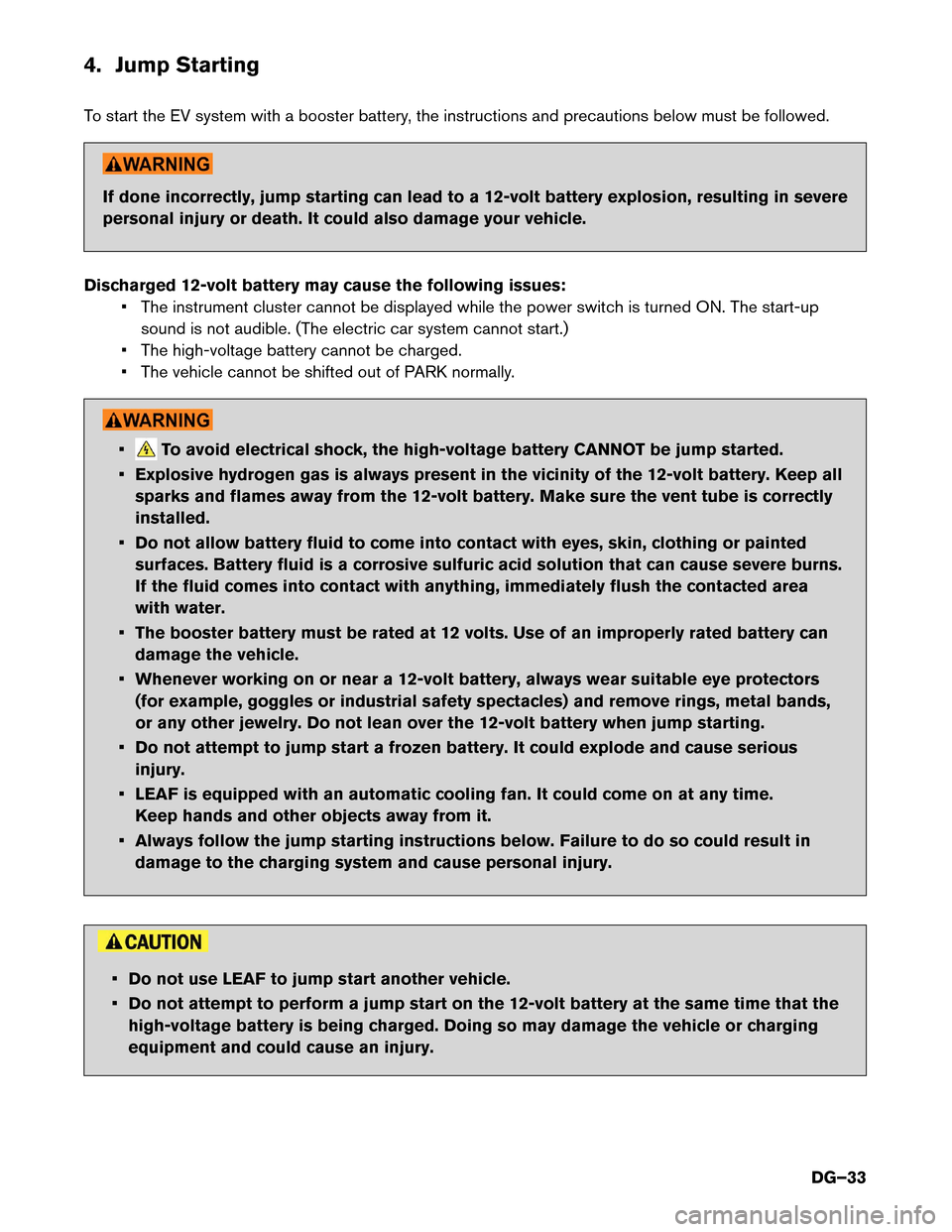
4. Jump Starting
T
o start the EV system with a booster battery, the instructions and precautions below must be followed. If done incorrectly, jump starting can lead to a 12-volt battery explosion, resulting in severe
personal
injury or death. It could also damage your vehicle.
Discharged 12-volt battery may cause the following issues: • The instrument cluster cannot be displayed while the power switch is turned ON. The start-upsound is not audible. (The electric car system cannot start.)
• The high-voltage battery cannot be charged.
• The vehicle cannot be shifted out of PARK normally. • To avoid electrical shock, the high-voltage battery CANNOT be jump started.
•
Explosive hydrogen gas is always present in the vicinity of the 12-volt battery. Keep all
sparks and flames away from the 12-volt battery. Make sure the vent tube is correctly
installed.
• Do not allow battery fluid to come into contact with eyes, skin, clothing or painted surfaces. Battery fluid is a corrosive sulfuric acid solution that can cause severe burns.
If the fluid comes into contact with anything, immediately flush the contacted area
with water.
• The booster battery must be rated at 12 volts. Use of an improperly rated battery can damage the vehicle.
• Whenever working on or near a 12-volt battery, always wear suitable eye protectors (for example, goggles or industrial safety spectacles) and remove rings, metal bands,
or any other jewelry. Do not lean over the 12-volt battery when jump starting.
• Do not attempt to jump start a frozen battery. It could explode and cause serious injury.
• LEAF is equipped with an automatic cooling fan. It could come on at any time. Keep hands and other objects away from it.
• Always follow the jump starting instructions below. Failure to do so could result in damage to the charging system and cause personal injury. • Do not use LEAF to jump start another vehicle.
•
Do not attempt to perform a jump start on the 12-volt battery at the same time that the
high-voltage battery is being charged. Doing so may damage the vehicle or charging
equipment and could cause an injury.
DG–33